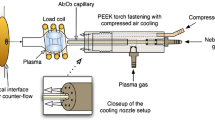Abstract
A fast, sensitive, interference-free, single enzyme single reagent glucose biosensor, operated in flow injection analysis (FIA) mode, was developed. The method used involved formation of colored complex of titanium sulfate reagent with the peroxide generated by glucose oxidase immobilized in a packed bed reactor. The color developed was detected spectrophotometrically in a flow cuvette. The system could measure down to 0.5 mg glucose l−1 and the response was reproducible and linear in the range 1 mg l−1 to 100 mg l−1. The analysis time for a 500 μl sample was 35 s and was free of interference from a number of substances tested. Analysis results using an off-line batch kit were observed to be in agreement with the developed system for determination of glucose in blood plasma samples.
Similar content being viewed by others
References
Benthin S, Nielsen J, Villadsen J (1992) Flow-injection analysis of micromolar concentrations of glucose and lactate in fermentation media. Anal. Chim. Acta 261: 145–153.
Clark LC Jr (1972) Family of polarographic enzyme electrodes and the measurement of alcohol. Biotechnol. Bioeng. Symp. 3: 377–394.
Eisenberg GM (1943) Colorimetric determination of hydrogen peroxide. Ind. Eng. Chem. 15: 327–328.
Hwang H, Dasgupta PK (1987) Tubular microporous membrane entrapped enzyme reactors for flow injection analysis. Anal. Chem. 59: 1356–1360.
Michal G, Mollering H, Siedel J (1983) Chemical design of indicator reactions for the visible range. In: Bergmeyer HU, ed. Methods of Enzymatic Analysis, Vol. 1, 3rd edn. Weinheim/Deerfield Beach, FL: Verlag Chemie Press, pp. 211–220.
Nandakumar MP, Sapre A, Lali A, Mattiasson B (1999) Monitoring of low concentrations of glucose in fermentation broth. Appl. Microbiol. Biotech. 52: 502–507.
Pilosof D, Nieman TA (1982) Microporous membrane flow cell with nonimmobilized enzyme for chemiluminescent determination of glucose. Anal. Chem. 54: 1698–1701.
Updike SJ, Shults MC, Kosovich K, Treichel I, Treichel PM (1975) Catalyst electrode specific for peroxide. Anal. Chem. 47: 1457–1459.
Weetall HH (1976) Covalent coupling methods for inorganic support materials. In: Mosbach K, ed. Methods in Enzymology, Vol. 44. New York: Academic Press, pp. 134–149.
Woodward J, Lennon KW, Zanin G, Wagner M, Scott MA (1985) Interaction between hydrogen peroxide and ferrous sulfate as a basis for glucose determinations. Biotechnol. Lett. 7: 197–202.
Author information
Authors and Affiliations
Rights and permissions
About this article
Cite this article
Sapre, A., Bedekar, A., Deshpande, A. et al. Analysis of micromolar concentrations of glucose by an interference free flow injection based biosensor. Biotechnology Letters 22, 569–573 (2000). https://doi.org/10.1023/A:1005624528652
Issue Date:
DOI: https://doi.org/10.1023/A:1005624528652



